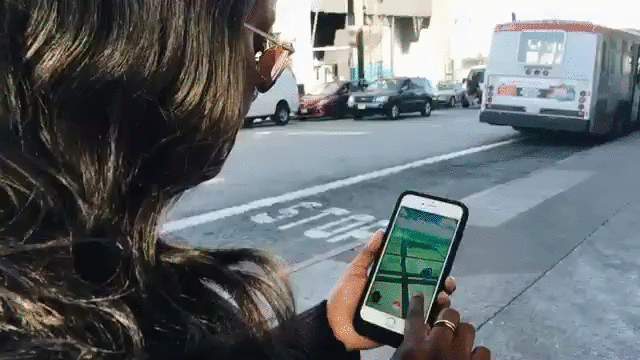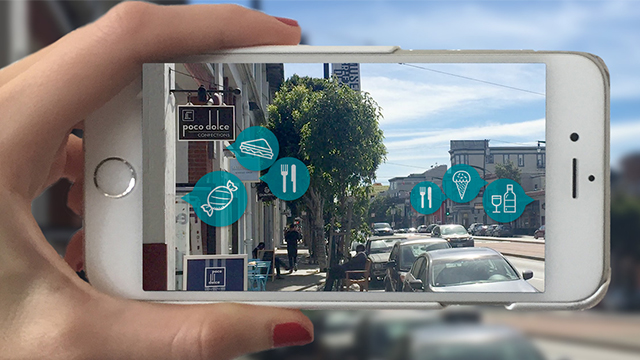Beyond Pokémon Go: A marketer’s guide to Augmented Reality
October 11, 2016Whether you’re secretly confused about Augmented Reality (AR) or it still feels vaguely sci-fi, you’re not alone.
Movies like Minority Report and Iron Man first showed us how images, sounds and data could be, literally, right at our fingertips. Tom Cruise fought the bad guys by merging real and virtual worlds. Then there’s the ever-changing news about Google Glass, Microsoft’s HoloLens and geeky devices ranging from gaming headsets to AR-equipped contact lenses. Or maybe you’ve seen filmmaker Keiichi Matsuda’s overwhelming (and somewhat terrifying) vision of a future ruled by AR. It’s a lot to process.
But whatever you know or imagine, AR is here – and you’re already using it.
- If you’ve ever Google Mapped your way to a meeting, that’s AR in action. It blends real life (you, en route to a physical destination) with computer-generated sounds, graphics or images (the blue line and voice instructions).
- AR enables players to chase virtual Pokémons while dodging very real streetlights and parking meters.
- It’s the same technology that puts a puppy face on your Snapchat selfie or gives your friend the high-pitched voice of a mule deer.
Here at BSTRO, we developed our first AR project in 2012. The Bard on the Beach iPhone app encouraged visitors to search the venue for our virtual Shakespeare, take a photo with the man himself, and upload it through the app. It was simple, but it opened our eyes to the possibilities of AR.
Now that AR is beginning to go mainstream, it’s driving some cool innovations – and marketers are taking notice. But before we talk about how to harness AR for your brand’s marketing strategy, let’s review the basics.

What is AR?
Augmented Reality superimposes virtual information over real-life experiences. As you walk down the street, AR glasses could show you which food trucks are parked in a three-block radius – and you wouldn’t even have to turn your head to find out. AR is a lot like Virtual Reality (VR), but VR is full simulation. It takes you inside a virtual world of animation, sound, images and graphics. It doesn’t interact with the natural environment in any way.
Both AR & VR are evolving fast, but there are still some sticky problems to solve. “Hardware is the biggest hurdle,” says Kevin Chan, BSTRO’s VP of Technology. “In order for people to use this technology their daily lives, AR devices will have to be portable, lightweight and powerful enough to create a seamless experience.”
What can AR do for me – and my customers?
AR can make it easier to interact with technology. It eliminates the screen as a barrier between real life and real-time information. An AR device could display a new email or find a nearby hotel room – directly from your field of vision. In a few years, we might not be staring down at smartphones or hunching over laptops (no more dreaded “tech neck”). Whether it’s sound, graphics, words or animations, AR layers technology over the natural environment.
Here’s how some leading brands have been using AR in their marketing strategies:
- Fashion retailer Topshop recently partnered with Microsoft Kinect to give shoppers a virtual try-on experience.
- Cosmetic brand Shiseido created an AR mirror that shows buyers what a product would look like on their own faces.
- In 2013, IKEA released an AR catalog that enabled shoppers to enter room measurements and see how a piece of furniture would look (and fit) in their own homes.
- Converse developed an iPhone app that allows shoe lovers to virtually try on different styles.
- Vespa ran an AR-enabled ad in the June 2014 issue of Wired magazine. Readers could download a custom app, scan the print image, then create and test-drive a customized scooter that seemed to zoom right off the page.
- Lego is creating AR kiosks where customers (big and small) can scan a Lego kit and see the finished product in three dimensions.
That’s just the beginning… More creative applications are popping up every week. If you’re thinking about Augmented Reality, here are some best practices to keep in mind.

1. Strategy before technology
“Anything you create needs to be useful or entertaining enough for customers to embrace it,” says BSTRO Creative Director Antonio Rusevski. “How does the technology relate to your product? Does it make sense for your business? Don’t be gimmicky or add AR just for the sake of trying something new.
2. Deepen the customer experience
AR apps and projects should add a fresh layer to the customer experience. Surprise and delight – and then take it a step further. A movie poster that uses AR to show the official film trailer is fun and engaging. “AR can strengthen connections with your brand community,” says Chan. “Give people extra information, make their lives easier, or create a more compelling, real-world experience.”
3. Streamline and simplify
Until the hardware is sorted out, most AR campaigns require users to scan an AR code or symbol, download and open a branded app, then experience AR through their smartphone screen. We’ll eventually have the tools to create field-of-vision AR overlays (“fish tacos around the corner!”). For now, try to keep these steps to a minimum. Think carefully through the process and be sure your AR app is worth the user’s time and effort.
4. Leverage current resources
About a dozen SDKs are already available (including at least one open source kit), so developing with existing technology can save time and money, says BSTRO developer Shaia Bak: “It makes sense to use the API of the existing frameworks. Then you can build on each iteration to bring your idea to life.”
Companies like Layar offer mobile AR browsers that bridge the gap between print and digital worlds. Smaller companies might choose to embed this kind of open source technology in their applications, while larger brands might need a custom app. Either way, it’s always smart to scale your efforts and grow with the technology.
From city streets to retail change rooms, Augmented Reality isn’t a sci-fi prediction – it’s already here. AR offers new ways for brands to engage with customers. It’s changing how we’ll access information of all kinds. But like every solid marketing effort, success flows from strategy. Start with a great idea, don’t lose sight of your customer, and you could have the next Pokémon GO on your hands.
—
If you’re thinking about Augmented Reality, get in touch. BSTRO uses strategy, storytelling and technology to engage communities and inspire action.
by Mary Puls
EVP Managing Director
